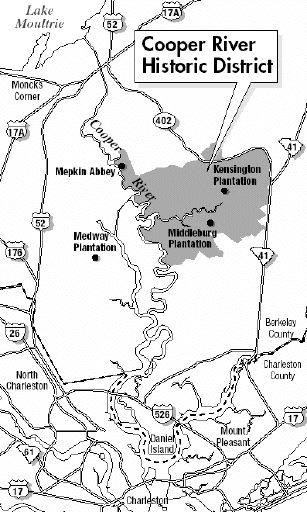Historical Cooper River
The Cooper River, a relatively short river system contained entirely within the lower portion of the South Carolina coastal plain and principally within Berkeley County, stretches north along the east side of the Charleston peninsula. Significant in the state’s history for more than three hundred years, it is the primary watershed for an area characterized by a complex network of tributaries, creeks, tidal marsh, and freshwater wetlands. The confluence of the river’s East and West branches, at a point historically known as the Tee, is approximately twenty miles north of where it empties into Charleston Harbor.
The headwaters of the East Branch are formed by Quinby and Huger Creeks in the Huger vicinity, while the West Branch begins some seventeen miles north of the Tee near Moncks Corner. These two branches, along with other tributaries and creeks, form the nucleus of an extremely fertile region consisting of tidal marshes, former tidal ricefields, inland ricefields and reserves, as well as upland agricultural fields and timbered and reforested woodlands.
Cooper River served not only as a principal transportation route for plantation goods, services, and people but also played a vital role in the successful production of rice. The earliest rice cultivation was on inland fields created from swamps and along creeks and branches at some distance from the river, in some cases more than a mile, and removed from tidal influence. During the mid-eighteenth century the technology to control tidal flooding of the fields was introduced to the Cooper River, and the tidal marshes became the focus of rice cultivation. In many cases the old inland fields were abandoned and appear as “Old Fields” or “Old Rice Fields” on eighteenth and nineteenth century maps and plats.

Historic Resources of the Cooper River, ca. 1670-ca. 1950
Name of Multiple Property Listing Berkeley County, South Carolina
United States Department of the Interior
National Park Service
National Register of Historic Places
Simply the Best In Blackwater Diving
COOPER RIVER DIVE CHARTERS






Today’s landscape features many fertile underwater fields along the river’s edge and inland freshwater swamps where rice once flourished. A complex system of dikes, dams, canals, and trunks, much of which is either still visible or nearly intact throughout the district, made rice production both possible and profitable. These landscape features are tangible evidence of the work of thousands of slaves who provided the labor force for the plantations.
By the mid-eighteenth century, the Cooper River served not only as a principal transportation route for plantation goods, services, and people but also played a vital role in the successful production of rice. The earliest rice cultivation was on inland fields created from swamps and along creeks and branches at some distance from the river, in some cases more than a mile, and removed from tidal influence.
During the mid-eighteenth century the technology to control tidal flooding of the fields was introduced to the Cooper River, and the tidal marshes became the focus of rice cultivation. In many cases the old inland fields were abandoned and appear as “Old Fields” or “Old Rice Fields” on eighteenth and nineteenth century maps and plats. Some inland fields, however, continued to be used with reservoirs, often called reserves, used for flooding the fields.
Today’s landscape features many fertile underwater fields along the river’s edge and inland freshwater swamps where rice once flourished. A complex system of dikes, dams, canals, and trunks, much of which is either still visible or nearly intact throughout the district, made rice production both possible and profitable. These landscape features are tangible evidence of the work of thousands of slaves who provided the labor force for the plantations.
The Cooper River Historic District contains an approximate twenty-five mile segment of the Cooper River system in Berkeley County. This includes the entire East Branch, a portion of the West Branch, and an area of the river below their confluence at the Tee. The river has a fairly deep channel (from twenty feet at the Tee to eight feet at the mouth of Quinby Creek) and was navigable by sloops and schooners along the section within the historic district.
The inclusion of the Cooper River as a contributing property in the district attests to its importance in transportation, industry and agriculture. Indeed, the river is the very heart of this district, an artery by which plantation goods were transported to and from markets in Charleston and elsewhere.

Simply the Best In Blackwater Diving
Copyright 2020








